Malcolm R. Campbell's Blog, page 21
September 29, 2023
Dang, Dumbledore is dead
 Gambon
Gambon
When he’s not Dumbledore he is (was) 82-year-old Michael Gambon. Natural causes, was it? Maybe that’s the cover story to obscure Snape’s role in the matter. After all, if you’ve seen the Harry Potter movies, you know that Snape has done it before. But Snape is twice dead. Once in the series and purportedly once in “real life” as Alan Rickman in 2016.
There’s a long list of denizens we can look at: Bellatrix Lestrange, Draco Malfoy, Lord Voldemort, Dolores Jane Umbridge, Lucius Malfoy, &c., &c. Like Snape, any of these characters could have escaped the “fiction” of the series and manifested in “real life.” That’s probably why Richard Harris (the first actor to play Dumbledore) died after the first two movies in the series in 2002 of Hodgkin’s lymphoma–according to the cover story.
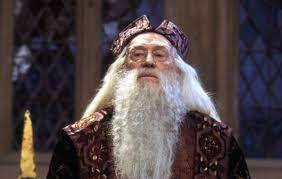 I’m biased in favor of Harris’ portrayal because I saw him once on the stage as well as in many movies and was used to his style (and his off-camera hijinks). He played a more ethereal Dumbledore than Gambon. Both were Irish and both were good in the role.
I’m biased in favor of Harris’ portrayal because I saw him once on the stage as well as in many movies and was used to his style (and his off-camera hijinks). He played a more ethereal Dumbledore than Gambon. Both were Irish and both were good in the role.
According to Variety, “While it is easier for a character actor, often working in supporting roles, to rack up a large number of credits than it is for lead actors, Gambon was enormously prolific, with over 150 TV or film credits in an era when half that number would be impressive and unusual — and this for a man whose body of stage work was also prodigious.”
Most readers and viewers don’t know that there’s a fine line between the fiction of novels and feature films and life as we think we know it. People tend to think they’re “safe” when the movie ends and when they reach the last page of the novel. Ha! I think not.
September 27, 2023
Last Oil and Gas Lease in the Montana’s Badger-Two Medicine Retired
National Parks Conservation Association
News Release – September 1, 2023
Washington, D.C. – Blackfeet leaders and conservationists celebrated today that they, along with the federal government, have reached a negotiated agreement with Solenex, LLC to permanently retire the last remaining federal oil and gas lease in the 130,000-acre Badger-Two Medicine area of the Helena-Lewis and Clark National Forest.

The settlement agreement marks the culmination of a 40-year effort by tribal leaders, conservationists, hunters and anglers, and other Montanans to prevent oil and gas drilling in the Badger-Two Medicine. Located adjacent to Glacier National Park and the Blackfeet Indian Reservation, the area is considered sacred ground by the Blackfeet Nation due to its deep cultural and historical significance to Blackfeet people as well as vital habit and a migration corridor for some of Montana’s most treasured wildlife species including elk, wolverines, grizzly bears, and westslope cutthroat trout.
 The 6,247-acre lease held by Solenex was one of 47 oil and gas leases originally issued by the Reagan Administration in the Badger-Two Medicine in the early 1980s. With today’s settlement agreement, all of these leases in the area have now been permanently eliminated without any development having occurred, ending the threat of drilling in this wild, roadless area once and for all. Read more here.
The 6,247-acre lease held by Solenex was one of 47 oil and gas leases originally issued by the Reagan Administration in the Badger-Two Medicine in the early 1980s. With today’s settlement agreement, all of these leases in the area have now been permanently eliminated without any development having occurred, ending the threat of drilling in this wild, roadless area once and for all. Read more here.
–
The existence of these leases was bad in multiple ways, two of them being that they threatened Blackfeet land and Glacier National Park as well the Bob Marshall Wilderness and Great Bear Wilderness.
Some years ago, when I was part of a group fighting a mine in British Columbia that released polluted water into the Flathead River on Glacier’s western boundary, we successfully used the US/Canada Boundary Waters Treaty to argue that the outflow from this mine would negatively impact lands and waters within the U.S. It took a while, but we got the mine closed.
 The lesson of this is that activities outside protected lands can bring pollution and other negative impacts to the flora and fauna inside those protected lands. Like the mine, the Solenex leases had that potential. Water and air pollution can be ubiquitous in that protected land boundaries don’t magically stop the inflow of pollution. At the time, I pushed an idea forward that would place concentric “circles” around protected areas in which nothing “dangerous” could be constructed. Naturally, this wasn’t passed. Development, such as that impacting Manassas National Battlefield Park aren’t always mines and oil pipes lines, but are commercial and neighborhood encroachments that that not only spoil views from with a park, but bring dust, traffic, and noise to areas that aren’t equipped to handle them.
The lesson of this is that activities outside protected lands can bring pollution and other negative impacts to the flora and fauna inside those protected lands. Like the mine, the Solenex leases had that potential. Water and air pollution can be ubiquitous in that protected land boundaries don’t magically stop the inflow of pollution. At the time, I pushed an idea forward that would place concentric “circles” around protected areas in which nothing “dangerous” could be constructed. Naturally, this wasn’t passed. Development, such as that impacting Manassas National Battlefield Park aren’t always mines and oil pipes lines, but are commercial and neighborhood encroachments that that not only spoil views from with a park, but bring dust, traffic, and noise to areas that aren’t equipped to handle them.
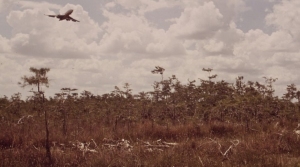 The proposed Everglades Jetport was another example of this: development near a protected area that negatively impacts a protected area. It’s hard to protect that which we want to protect when nearby construction, commercial and residential projects, and superhighways threaten what we have set aside as “sacred.”
The proposed Everglades Jetport was another example of this: development near a protected area that negatively impacts a protected area. It’s hard to protect that which we want to protect when nearby construction, commercial and residential projects, and superhighways threaten what we have set aside as “sacred.”
When we protect land, we think, “there, that’s taken care of” as we move on to other issues. No, it’s never taken care of. Developers are always on the porch trying to get a foot in the door.
–Malcolm
September 26, 2023
Thistle Farms helps ‘women survivors overcome and heal from systems of prostitution and exploitation.’
 I discovered Thistle Farms in Nashville while looking at the list of grantees of the Isabell Allende Foundation. According to Thistle Farms’ website:
I discovered Thistle Farms in Nashville while looking at the list of grantees of the Isabell Allende Foundation. According to Thistle Farms’ website:
Your support helps create sanctuary and healing for women survivors.
2 Years of Free HousingHealthcare and Trauma TherapyMeaningful EmploymentAdvocacy and Public Policy InitiativesIt’s horrifying to discover just how many women, including those in the United States, need this kind of sanctuary. In addition to donations, Thistle Farms supports its programs through the sale of candles, essential oils, soaps, and similar products that you can find here.
The organization houses “up to 36 residents at a time in a therapeutic setting that offers healing and transformation through housing, healthcare, counseling, employment, and community building. Housing and clinical services are free of charge and provided without Federal assistance. Five years after program completion, 75% of our graduates are living healthy, independent lives. Broken relationships have been restored. Hopelessness has been replaced with hope.”
In an on-site article called “The Many Faces of Human Trafficking,” Tasha Kennard writes, “90-percent of sex trafficking victims in the US are female, of which women and girls of color make up a disproportionate number of trafficked individuals. Meanwhile, the overwhelming majority of those purchasing sex – creating the demand that drives even more bodies into the sex trade – are men.
“Most of the women Thistle Farms serves report having first experienced sexual abuse between the ages of 7-11, began using alcohol or drugs by the age of 13 as a means of coping with trauma, and are first on the streets between the ages of 14 and 16.”
The problem is worse than most of us know. According to Child USA, “1 in 5 girls and 1 in 13 boys are sexually abused before the age of 18.” Empower The Fight states, “Human trafficking is the fastest-growing organized crime activity in the United States. Estimating 250,000 children per year are victims of sex trafficking. Most older children are trafficked while still going to school and living at home!”
I celebrate the organizations such as Thistle Farms that help fight the results of this evil and, like many, am surprised that it’s so pervasive in the U.S., especially within indigenous groups.
–Malcolm
September 25, 2023
‘Buffalo Dreamers’ by John Newman
This novel was published by Sweetgrass Books (Farcountry Press) on October 4, 2022, and is set in Montana, my favorite state.
From the Publisher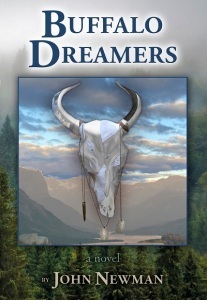 “A YOUNG MARINE PROTECTS WHAT IS MOST SACRED
“A YOUNG MARINE PROTECTS WHAT IS MOST SACRED
“For Sam Comstock, a young Iraq war vet with PTSD, the need to find a way to heal his wounded soul is a matter of life or death. His Marine sniper skills lead him to Montana on a mission to help manage an infamous wildlife challenge: killing migratory buffalo outside Yellowstone Park that are presumed to carry an infectious disease for cattle. This places Sam seriously at odds with a renegade band of Indian warrior-dreamers who are determined to save the buffalo from slaughter. Thrown together and isolated in the Montana wilderness, meanwhile relentlessly pursued by the combined forces of military, law enforcement, and the cattle industry, Sam and his native compatriots must depend upon one another for survival. Along the way, Sam becomes enmeshed in the way of the buffalo, confronting his suicidal pain and emerging from a long trail of suffering.
“Through Sam, we come to understand that we have much to learn from our native neighbors. We may even discover our own inner buffalo spirit.”
The Way of the BuffaloIn an article called “The Meaning of the Buffalo to Our People,” Karlene Hunter cites an article by Richard Williams that states, “The American Indian and the buffalo coexisted in a rare balance between nature and man. The American Indian developed a close, spiritual relationship with the buffalo. The sacred buffalo became an integral part of the religion of the Plains Indian. Furthermore, the diet of primarily buffalo created a unique physiological relationship. The adage “You are what you eat” was never more applicable than in the symbiotic relationship between the buffalo and the Plains Indian. The Plains Indian culture was intrinsic with the buffalo culture. The two cultures could not be separated without mutual devastation.”
From Kirkus Reviews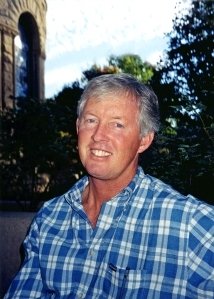 Newman
Newman
“Over the course of this novel, Newman writes with a vivid sense of place (“The snow fell all night, cleansing the blood-stained ground and creating a white canvas upon which creatures large and small could paint the tracks of the new day”) and a palpable respect for Montana’s land and its many denizens. Smith is something of a one-dimensional villain that would have benefited from deeper character development. However, Sam’s captors are depicted with a sense of depth and great sensitivity. The scenes involving the slaughter of bison and cattle are certainly brutal (“the blood now flowing freely across the roadway, the men tracking it every direction”) but not exploitatively so.
“A compelling and empathetic story of salvation.”
–Malcolm
September 24, 2023
Potpourri for Sunday, September 14, 2023
 Before reading Kathy Reichs’ novel Fatal Voyage, I had never heard the term “DMORT” even though teams from this agency help investigate airline crashes with a focus on passengers; remains. The acronym stands for Disaster Mortuary Operational Response Teams, and I suppose they don’t make the news because (a) the public doesn’t want to hear about the dead, and (b) news organizations tend to focus on why a plane crashed. According to the Administration for Strategic Preparedness and Response, “When natural or man-made disaster strikes, sometimes there are more fatalities than local resources can manage. Disaster Mortuary Operational Response Teams (DMORTs) support local mortuary services on location, working to quickly and accurately identify victims and reunite victims with their loved ones in a dignified, respectful manner.” After reading Fatal Voyage, I have a new appreciation for the kinds of people who can deal with the heart-breaking carnage and make sense of it for the families of the victims.
Before reading Kathy Reichs’ novel Fatal Voyage, I had never heard the term “DMORT” even though teams from this agency help investigate airline crashes with a focus on passengers; remains. The acronym stands for Disaster Mortuary Operational Response Teams, and I suppose they don’t make the news because (a) the public doesn’t want to hear about the dead, and (b) news organizations tend to focus on why a plane crashed. According to the Administration for Strategic Preparedness and Response, “When natural or man-made disaster strikes, sometimes there are more fatalities than local resources can manage. Disaster Mortuary Operational Response Teams (DMORTs) support local mortuary services on location, working to quickly and accurately identify victims and reunite victims with their loved ones in a dignified, respectful manner.” After reading Fatal Voyage, I have a new appreciation for the kinds of people who can deal with the heart-breaking carnage and make sense of it for the families of the victims. We have finally gotten around to watching the PBS series “Atlantic Crossing” which first ran in 2021 on PBS. The focus here is the plight of Norway in World War II. PBS says that “A European princess steals the heart of the U.S. president in an epic drama inspired by the real World War II relationship between Franklin Roosevelt and Norwegian Crown Princess Martha.” Norway had expected to be spared a German invasion due to its neutrality, but the Germans invaded anyway, forcing the monarchy to flee to England where it established a government in exile. We have enjoyed the series, especially since it covers a portion of World War II that is often neglected in overviews of the war.
We have finally gotten around to watching the PBS series “Atlantic Crossing” which first ran in 2021 on PBS. The focus here is the plight of Norway in World War II. PBS says that “A European princess steals the heart of the U.S. president in an epic drama inspired by the real World War II relationship between Franklin Roosevelt and Norwegian Crown Princess Martha.” Norway had expected to be spared a German invasion due to its neutrality, but the Germans invaded anyway, forcing the monarchy to flee to England where it established a government in exile. We have enjoyed the series, especially since it covers a portion of World War II that is often neglected in overviews of the war. I often print news releases on this blog that come from PEN America because they focus on attacks on our freedoms of speech and press. According to PEN’s website, “Our strength is our membership—a nationwide community of novelists and nonfiction authors, journalists, editors, poets, screenwriters, essayists, playwrights, publishers, translators, agents, and other literary professionals, and an even larger network of devoted readers and supporters who join with them to carry out PEN America’s mission.” I would join if I could, but the cost is dear at $50. I’m just happy that PEN’s website is available to all who stop by. Keeping up with the issues of press and speech freedom are, to me, mandatory.
I often print news releases on this blog that come from PEN America because they focus on attacks on our freedoms of speech and press. According to PEN’s website, “Our strength is our membership—a nationwide community of novelists and nonfiction authors, journalists, editors, poets, screenwriters, essayists, playwrights, publishers, translators, agents, and other literary professionals, and an even larger network of devoted readers and supporters who join with them to carry out PEN America’s mission.” I would join if I could, but the cost is dear at $50. I’m just happy that PEN’s website is available to all who stop by. Keeping up with the issues of press and speech freedom are, to me, mandatory.–Malcolm
September 23, 2023
PEN America: ‘Book Bans Spike 33% in 2022-23 School Year’
According to a new report from PEN, “Since PEN America started tracking public school book bans in July 2021, we have recorded nearly 6,000 instances of banned books. Our new report released today documents a 33% increase in book bans in 2023-23 compared to 2021-21, of which 40% occurred in Florida.
“A large share of the individual bans took place in states where legislation or coordinated campaigns by local and national groups have driven mass restrictions on access to literature. Books about race and racism, LGBTQ+ identities, and violence have remained a top target.”
You can read the report here.

Book banning is, I think, part of the recent trend that includes a variety of governmental and private actions focused on reducing our freedoms of speech and press.
 According to Freedom House, “The fundamental right to seek and disseminate information through an independent press is under attack, and part of the assault has come from an unexpected source. Elected leaders in many democracies, who should be press freedom’s staunchest defenders, have made explicit attempts to silence critical media voices and strengthen outlets that serve up favorable coverage. The trend is linked to a global decline in democracy itself: The erosion of press freedom is both a symptom of and a contributor to the breakdown.”
According to Freedom House, “The fundamental right to seek and disseminate information through an independent press is under attack, and part of the assault has come from an unexpected source. Elected leaders in many democracies, who should be press freedom’s staunchest defenders, have made explicit attempts to silence critical media voices and strengthen outlets that serve up favorable coverage. The trend is linked to a global decline in democracy itself: The erosion of press freedom is both a symptom of and a contributor to the breakdown.”
All of those who value speech and press freedom should, I think, speak out against this attack on the press. Otherwise, it will become policy even here in the United States. What worries me is that issues in this country have become so partisan with badly slanted news coverage that people are now justifying limiting the rights of those with whom they disagree. It’s as though the people with alternative ideas are without rights.
 The U.N. says “Reporters getting killed while chasing a story. Online attacks against women journalists, including death and rape threats. Targeted electronic surveillance to intimidate and silence investigative journalism. This is the dangerous reality for many journalists around the world as media freedom and safety have diminished in the digital age with a grave impact on human rights, democracy, and development.”
The U.N. says “Reporters getting killed while chasing a story. Online attacks against women journalists, including death and rape threats. Targeted electronic surveillance to intimidate and silence investigative journalism. This is the dangerous reality for many journalists around the world as media freedom and safety have diminished in the digital age with a grave impact on human rights, democracy, and development.”
 According to the PEN report, “Hyperbolic and misleading rhetoric about ‘porn in schools’ and ‘sexually explicit,’ “harmful,’ and ‘age inappropriate’ materials led to the removal of thousands of books covering a range of topics and themes for young audiences. Overwhelmingly, book bans target books on race or racism or featuring characters of color, as well as books with LGBTQ+ characters. This year, banned books also include books on physical abuse, health and well-being, and themes of grief and death. Notably, most instances of book bans affect young adult books, middle-grade books, chapter books, or picture books—books specifically written and selected for younger audiences.”
According to the PEN report, “Hyperbolic and misleading rhetoric about ‘porn in schools’ and ‘sexually explicit,’ “harmful,’ and ‘age inappropriate’ materials led to the removal of thousands of books covering a range of topics and themes for young audiences. Overwhelmingly, book bans target books on race or racism or featuring characters of color, as well as books with LGBTQ+ characters. This year, banned books also include books on physical abuse, health and well-being, and themes of grief and death. Notably, most instances of book bans affect young adult books, middle-grade books, chapter books, or picture books—books specifically written and selected for younger audiences.”
Those who promote these bans are, quite likely, afraid of the truth. If not, why ban it? In part, there’s a growing patriarchal approach by the government and opinion groups that want to control what we can read. This is unconstitutional on the face of it, so I wonder why so many people are silent and sit at home watching it happen.
If you live in Florida, Texas, Missouri, Utah, or Pennsylvania, wake up. Or are you sheep, content to eat what the establishment chooses to feed you?

This is not America. This is biased patriarchy run amok on many levels. We need to declare zero tolerance for those who say they should control what we read, hear on the news, and see online. They have no place here and need to move to Russia, China, or North Korea where their views are considered sacred.
–Malcolm
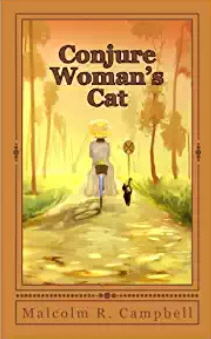 Malcolm R. Campbell writes novels about fighting the KKK, a group that lives on today through its attempts to cancel our freedoms.
Malcolm R. Campbell writes novels about fighting the KKK, a group that lives on today through its attempts to cancel our freedoms.
September 21, 2023
I almost feel bad pressing charges when a woman steals my wallet and only takes $30
Without my noticing it, my wallet got shoved off the counter onto the floor at a local pharmacy. When I realized I didn’t have it, I went back to the pharmacy where they used their video and discovered that a woman had come into the store, picked up the wallet, and put it in her purse. The pharmacy called the police.
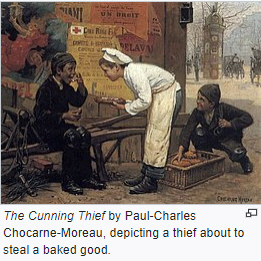 The woman was caught because she got an injection at the pharmacy which created a record of her visit along with her name and address. It didn’t take the police long to find her. She confessed to taking the wallet, saying that she kept the cash and tossed the wallet out the car window. All this happened before I even left the store.
The woman was caught because she got an injection at the pharmacy which created a record of her visit along with her name and address. It didn’t take the police long to find her. She confessed to taking the wallet, saying that she kept the cash and tossed the wallet out the car window. All this happened before I even left the store.
The officer asked if I wanted to press charges. Assuming at that point that the woman had used one or more of the VISA/MC cards and that I was looking toward the hassle of getting a new driver’s license, medicare card, and a set of all new credit cards, I said “yes.” Later the wallet was found with all the cards &c. untouched by somebody who was kind enough to bring it to my house with no idea the police had arrested a thief in the matter of that wallet.
Of course, I know nothing about the thief, mainly whether or not this kind of thing is a habit with her or whether she has a police record. If she has no record, I can’t really see her going to jail for stealing $30. I definitely have mixed feelings about this, and that goes to show you that I’d never make it as a cop, a DA, or a judge.
In Georgia, misdemeanor theft can lead to up to one year in jail. I hope she gets a community service sentence instead unless the whole thing is dismissed since the amount was so small– and (if) she gives me the money back.
I may never know how this ends up. What would you have done if this happened to you?
–Malcolm
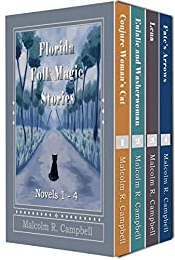 Malcolm R. Campbell is the author of the Florida Folk Magic series. All four novels are available at a savings in this Kindle version.
Malcolm R. Campbell is the author of the Florida Folk Magic series. All four novels are available at a savings in this Kindle version.
September 18, 2023
Jews in WWII: history’s defining moment
 As I read Isabel Allende’s The Wind Knows My Name which begins when Samuel Adler’s father who disappears during Kristallnacht, I think that the plight of the Jews at the hands of the Germans and others is the primary event in recent history that defines the state of the world. There are, perhaps, some 70,000 books about the war. As for those directly related to Geman, Russian, and other countries’ crimes against the Jewish people, I cannot determine.
As I read Isabel Allende’s The Wind Knows My Name which begins when Samuel Adler’s father who disappears during Kristallnacht, I think that the plight of the Jews at the hands of the Germans and others is the primary event in recent history that defines the state of the world. There are, perhaps, some 70,000 books about the war. As for those directly related to Geman, Russian, and other countries’ crimes against the Jewish people, I cannot determine.
It’s hard to read such novels and nonfiction accounts without Xanax and/or Scotch to tame the horror in one’s mind and stomach at the unmitigated cruelty against one of the world’s major ethnic groups without rational purpose–unless you consider myths rational enough to justify it.
What bothers me is that the myths are illogical rationale for targeting the Jews are still with us, even within the U.S. where one would think we’ve outgrown such hatred. You can follow the fight 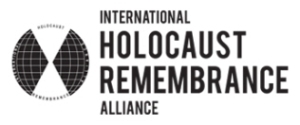 against this evil by looking at the International Holocaust Remembrance Alliance. According to its website, ” The IHRA identifies the practical needs of policymakers, scholars, educators, and museum professionals working in the Holocaust remembrance sector, and it produces materials to support the work of these stakeholders. Resources such as IHRA academic publications, educational guidelines, and reports are written by experts for the benefit of non-experts, helping to ensure that the IHRA’s expertise can serve a highly practical function throughout IHRA’s member countries and beyond.”
against this evil by looking at the International Holocaust Remembrance Alliance. According to its website, ” The IHRA identifies the practical needs of policymakers, scholars, educators, and museum professionals working in the Holocaust remembrance sector, and it produces materials to support the work of these stakeholders. Resources such as IHRA academic publications, educational guidelines, and reports are written by experts for the benefit of non-experts, helping to ensure that the IHRA’s expertise can serve a highly practical function throughout IHRA’s member countries and beyond.”
I believe we owe it to ourselves and to the Jewish people to stay informed about the ongoing problems rather than assuming that since we see nothing bad happening outside our windows, there are no issues to fight.
From the publisher, we read, “The lives of a Jewish boy escaping Nazi-occupied Europe and a mother and daughter fleeing twenty-first-century El Salvador intersect in this ambitious, intricate novel about war and immigration” (People), from the New York Times bestselling author of A Long Petal of the Sea and Violeta. “Allende’s storytelling walks a lyrical romanticism on roads imposed by social and political turmoil.”
The danger, I think, is believing that such problems are gone with the wind. They are not. They live with more vitality than any of us would believe.
–Malcolm
September 17, 2023
‘Days at the Morisaki Bookshop’ by Satoshi Yagisawa
 What book lover could resist this shop?
What book lover could resist this shop?
“‘Days at the Morisaki Bookshop'” is a sweet, gentle tale about the power of books to bring solace to troubled souls and offer them hope for the future. The title takes us inside a bookshop housed in an old wooden building on a quiet corner of a Tokyo district that has come to be known as ‘Book Town.’” – Karen Heenan-Davies at Bookertalk
From the Publisher“The wise and charming international bestseller and hit Japanese movie—about a young woman who loses everything but finds herself—a tale of new beginnings, romantic and family relationships, and the comfort that can be found in books.
“Twenty-five-year-old Takako has enjoyed a relatively easy existence—until the day her boyfriend Hideaki, the man she expected to wed, casually announces he’s been cheating on her and is marrying the other woman. Suddenly, Takako’s life is in freefall. She loses her job, her friends, and her acquaintances, and spirals into a deep depression. In the depths of her despair, she receives a call from her distant uncle Satoru.
 Satoshi Yagisawa
Satoshi Yagisawa
“An unusual man who has always pursued something of an unconventional life, especially after his wife Momoko left him out of the blue five years earlier, Satoru runs a second-hand bookshop in Jimbocho, Tokyo’s famous book district. Takako once looked down upon Satoru’s life. Now, she reluctantly accepts his offer of the tiny room above the bookshop rent-free in exchange for helping out at the store. The move is temporary until she can get back on her feet. But in the months that follow, Takako surprises herself when she develops a passion for Japanese literature, becomes a regular at a local coffee shop where she makes new friends, and eventually meets a young editor from a nearby publishing house who’s going through his own messy breakup.
“But just as she begins to find joy again, Hideaki reappears, forcing Takako to rely once again on her uncle, whose own life has begun to unravel. Together, these seeming opposites work to understand each other and themselves as they continue to share the wisdom they’ve gained in the bookshop.
“Translated By Eric Ozawa”
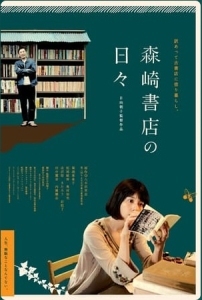 The novel was published in 2009 with the English translation being released this past summer. The story appeared in 2010 as the film “Morisaki shoten no hibi” directed by Asako Hyuga and starring Ryô Iwamatsu and Akiko Kikuchi. Watch the trailer here.
The novel was published in 2009 with the English translation being released this past summer. The story appeared in 2010 as the film “Morisaki shoten no hibi” directed by Asako Hyuga and starring Ryô Iwamatsu and Akiko Kikuchi. Watch the trailer here.
According to Japanese Comfort Reads, “The crime genre seems to be over-represented among Japanese novels in translation, and there are plenty of highbrow books too that someone has decided represent the best of Japanese literature. I enjoy all of these, but surely there is room for novels that satisfy a different need, novels that would entice both a 16-year-old girl and an 80-year-old man?”
–Malcolm
September 16, 2023
Ahhhhh, ‘Rhapsody in Blue’
My favorite color is blue. While haint blue is useful on porches and front doors, it’s too light for a signature color. I need navy blue, the blue of ocean water just before the light is gone, the blue of twilight over the city. Naturally, I love the blues which is why I mentioned them often in my novel Conjure Woman’s Cat and its sequels.
According to SantaFe.com, “Blues is the name given to the musical form and the music genre that emerged from the African-American communities and the black cultural melting pot of the American South of the 1890’s, drawing on a fascinating mixture of African-American spirituals, traditional songs, work songs of the slaves, field hollers, shouts and chants, folk ballads, European hymns, contemporary dance music and rhymed simple narrative ballads. During their back-breaking toil in the fields of the Southern plantations, black slaves developed a “call and response” way of singing to give rhythm to the drudgery of their work.”
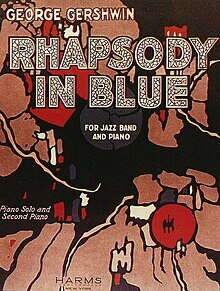 While I especially like the blues when sung with a piano or guitar accompaniment, I fully appreciate George Gershwin’s 1924 instrumental approach for piano and jazz band, “Rapsody in Blue,” that I first heard on my father’s 78 rpm records. The composition was controversial from the beginning because it mixed classical music and jazz.
While I especially like the blues when sung with a piano or guitar accompaniment, I fully appreciate George Gershwin’s 1924 instrumental approach for piano and jazz band, “Rapsody in Blue,” that I first heard on my father’s 78 rpm records. The composition was controversial from the beginning because it mixed classical music and jazz.
According to Wikipedia, “The Rhapsody is one of Gershwin’s most recognizable creations and a key composition that defined the Jazz Age. Gershwin’s piece inaugurated a new era in America’s musical history, established Gershwin’s reputation as an eminent composer, and eventually became one of the most popular of all concert works. In the American Heritage magazine, Frederic D. Schwarz posits that the famous opening clarinet glissando has become as instantly recognizable to concert audiences as the opening of Beethoven’s Fifth Symphony.”
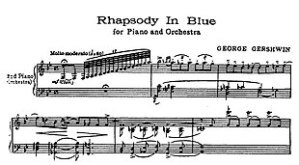 As a clarinet player in high school and college bands, that opening glissando caught my attention and never let it go. First, it was a perfect beginning to the piece. Second, I couldn’t play that 17-note gliding upward cry on my clarinet for love or money. (Not that anyone offered either.) You can hear a YouTube performance here.
As a clarinet player in high school and college bands, that opening glissando caught my attention and never let it go. First, it was a perfect beginning to the piece. Second, I couldn’t play that 17-note gliding upward cry on my clarinet for love or money. (Not that anyone offered either.) You can hear a YouTube performance here.
What Gershwin produced was not a “jazz concerto” but a rhapsodic work for “piano and jazz band” incorporating elements of European symphonic music and American jazz with his inimitable melodic gift and keyboard facility.
As Classic FM notes, “Gershwin’s original title for it was American Rhapsody. But, by chance, Ira had been to an exhibition of Whistler’s paintings and saw the painter’s Nocturne In Blue And Green of the Thames at Chelsea. Why not call the new piece Rhapsody In Blue instead, he suggested. The title would reflect the European and American influences. Also at Ira’s suggestion, George contrasted the syncopated character that dominates the tune with an expressive romantic theme the composer had previously improvised at a party.”
And so the music plays forever in our consciousness even when we don’t have a band or a record or an audio file.
–Malcolm



